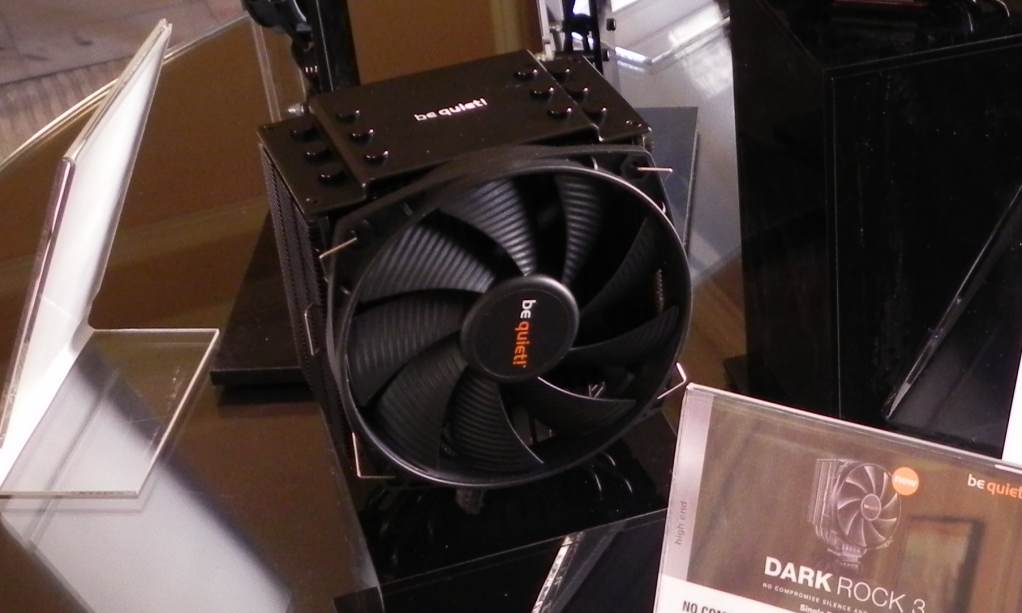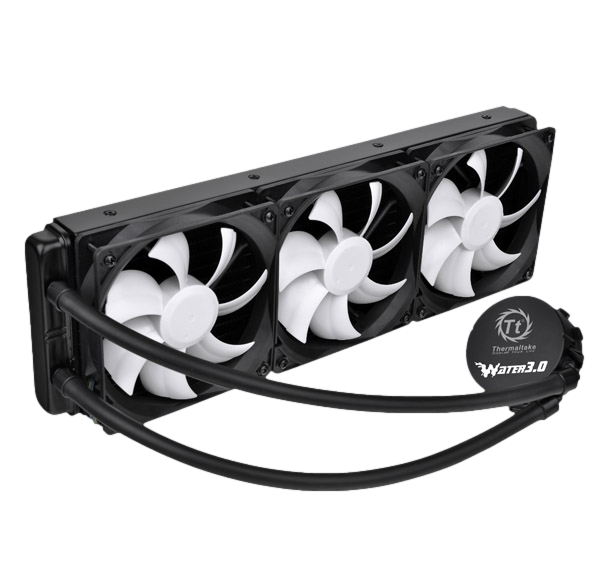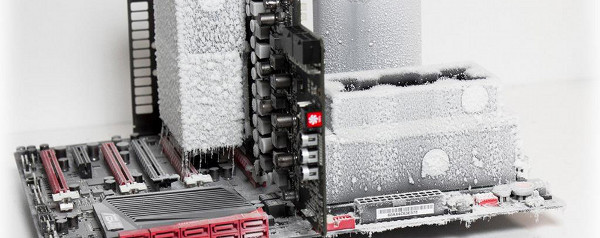WHAT ABOUT COOLING?
When it comes to cooling, there is an easy relationship to remember and abide by … more is always better. Realistically, if you can’t decide between two graphics cards, one of which has a single fan and the other has two fans (both the same size and quality) the choice is easy.
There are three main types of cooling mechanisms you will find with graphics cards. The first being simple transfer of heat from the component to a small heatsink, this is also called passive cooling. A common place to find passive cooling is on your RAM modules.
The second type of cooling mechanism is via active cooling. A platform sits on top of the graphics card component, such as the GPU and transfers the heat to a large surface area. Further a fan, or two or three, will help pull that heat away from the expanded surface area to permit for further heat transfer. This is one of the most common, if not the most common, method of graphics card cooling.
The third method for cooling a graphics card is via liquid cooling. Similar to the method listed above, a platform directly connects to the main heat-producing component of the graphics card (yes, the GPU again). However, rather than the heat radiating across a larger surface area, liquid from within the cooling mechanism increases in temperature as it transferred from that platform to the liquid, and the liquid is brought to a radiator that usually features a fan that will further remove the heat from the liquid. This method is more common for higher end graphics cards and for custom modifications.
There is one more method worth mentioning, that looks rather interesting, which is liquid nitrogen cooling. This involves, you guessed it, utilizing liquid nitrogen to ultimately cool the GPU. This method is highly unconventional and is primarily used by those who wish to over clock their graphics card to the extreme.
After reviewing these possible cooling mechanisms, it is possible that it may play a large role in your choice of graphics card. You may find that the card may be too large for the chassis you wish to put it in due to the extra-large cooling mechanism, or that you already have an all-in-one water-cooling system set up in your gaming rig for your CPU and there simply is no room for a water-cooling mechanism for that new graphics card. It is highly recommended that you take a quick look at the dimensions of the card, and measure out your rig. A simple step that could save you hours of headache and a few extra bucks. When it comes to choosing a cooling mechanism, just consider how you plan to use the card: watching the odd movie here and there on your 22 inch monitor or playing Titanfall on a 4K monitor with 3D settings turned up to max.
CAN I OVERCLOCK MY GPU, JUST LIKE MY CPU?
Sure, knock yourself out! All kidding aside, you can definitely over clock your graphics card for better performance, however is it necessarily worth it? That’s the better question. Simply put, over clocking is the process of increasing the clock rate of a processor above what is set by the manufacturer, which can result in increased performance. A processing unit, like a CPU or GPU, will have an ideal and optimal range in which over clocking provides increased performance. If the clock rate is increased too far, the processor will become unstable and crash, or worse! There are other variables that come into play when over clocking, but one of the biggest is cooling.
The only true test for whether over clocking is worth it or not, is to actually over clock your card, and try it out with the games you play. If you have over clocked your card safely and correctly, then you will notice a small boost in performance, and the card will continue to run safely at moderate temperature. LifeHacker posted an article about a year ago that excellently gives you a step by step guide on how to over clock your graphics card, which is the video we have posted below. A couple of things to keep in mind before you get excited about over clocking your graphics card: over clock at your OWN RISK. This process can quickly diminish the life span of your graphics card if you are not careful! Secondly, keep a very close eye on the temperature of your graphics card as you are testing. Our advice it to go out to your local hardware store and pick up a laser thermometer, we picked one up recently for just under $15. While we have done some over clock testing in the past, we noticed that even though the temperature of the graphics card listed in the benchmark is within acceptable range, the actual temperature of the PCB and underlying capacitors well exceeded normal operating temperatures, and was bad news!
Looks easy, doesn’t it? The over clocking process is quite easy, using a tool like MSI Afterburner, slowly bump up the Core Clock Rate by 10 to 25 MHz until you start to see artifacts or it crashes. Knock the clock rate back down an interval, and you are away to the races. If you really want to push the performance of the card, you can experiment by slowing increasing Memory Clock Rate the same way. Going one step further you can even bump up the Core Voltage in 10 mV increments to push out a few more FPS.
A final word of warning, as we have already mentioned, please over clock your GPU at your own risk (Essentially Tech Media Corp. takes no responsibility for any damage caused to your graphics card by over clocking). Please make sure you do your research first, head over to Google, search for your card being over clocked and see how other users have pushed the limits on the card. More than likely, you will save yourself from frying the card, and save some time in determining the best clock rate and voltage.
On the flip side of the coin, why not just look at upgrading your card? Sure if money is in shortfall than this is an excellent option to bring some new life into your card, however that new life you are bringing in to the card … is just the life the graphics card had saved for the future. It might actually save you time and money to upgrade your card to a newer edition, and sell your older card at your next garage sale or online. It may save you from having to buy a new one anyways because over clocking fried your older one. Just some food for thought as you may even find out that the card you were looking to over clock, which comes from the factory over clocked, may not have any more juice to squeeze out of it or it may be a poor over clocking candidate.
 Technology X Tomorrow's Technology Today!
Technology X Tomorrow's Technology Today!





Helpful
very helpful
Good article. I used it in one of my college papers
That is perhaps one of the best compliments to this site; thank you.
Now I feel like a huge Geek whenever I explain this stuff to my friends… this is awesome.
Will the next gen card be called Radeon R9 490?
We wouldn’t be able to tell you even if we knew, but most likely.
I was just going the fact the previous cards were 290 and 390 I figured the next logical choice was 490. unless Titan is the name of all cards from now on
if other parts of the site are as good as this article then I’ll have to add this site to my Computer technology bookmark folder.
Care to elaborate? We are always looking for suggestions.
– this is something new. Actually, processors have built-in graphics. Besides, why didn’t you mention the AMD A6/8/10 processors, that are not on par with Intels considering their CPU performance, but if we compare the graphics power, this is where Intel is still far behind even with its Intel 4000.
Besides, look for prices: https://hardware.nl/catalogsearch/result/index/?lang=en_US&manufacturer=AMD&q=AMD+A10
So, if you are not going to play video games, then forget about an additional power-hungry stuff. Such AMD processor will handle even some games. Other than this remark, the article is pretty good to me.
Valid point. APU’s are a great option if your budget doesn’t let you go all out and get a dedicated card.
Take a look at our review of the A8 – AMD A10 7870K CPU Review – Welcoming Competition! or even the A10 – AMD A8 7650K APU Review – The Little APU That Could! … Both show that these are excellent graphics options, which don’t require integrated graphics.
Apu’s are the future eventually discrete gpu’s will become obsolete. AMD made a big step in the right direction with the development of the apu and HSA.
best content for noobie
now i feel like a graphics god XD